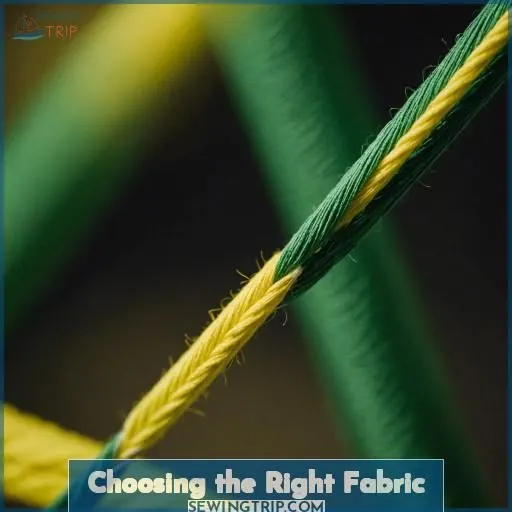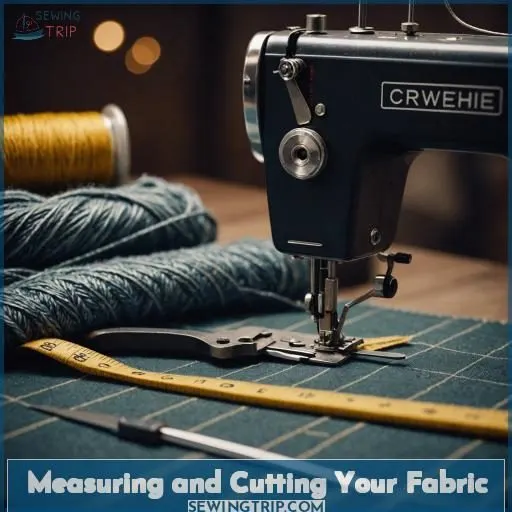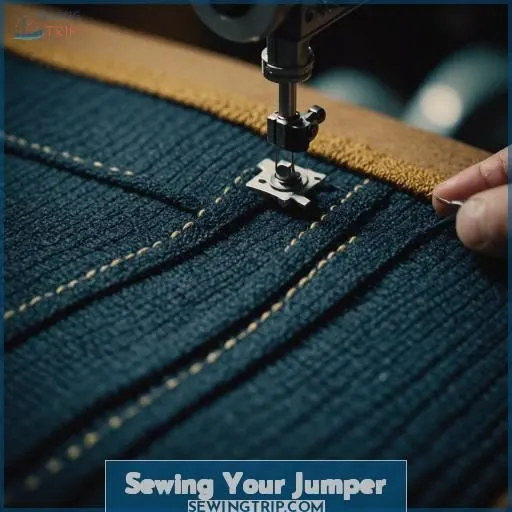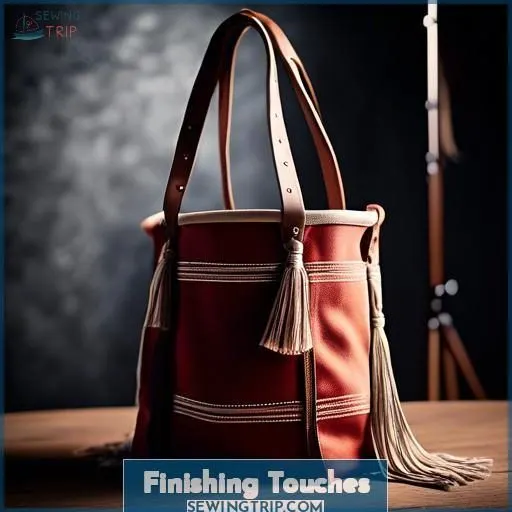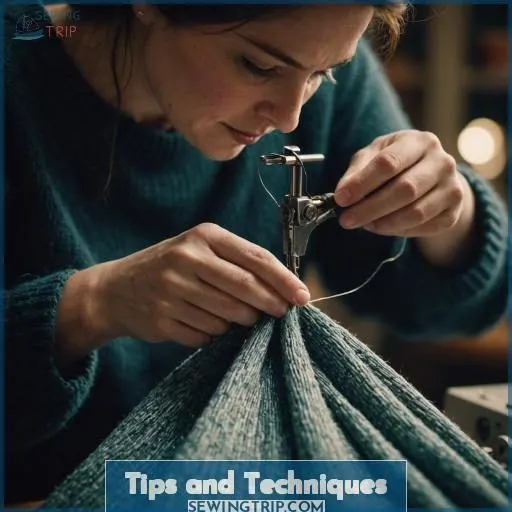This site is supported by our readers. We may earn a commission, at no cost to you, if you purchase through links.
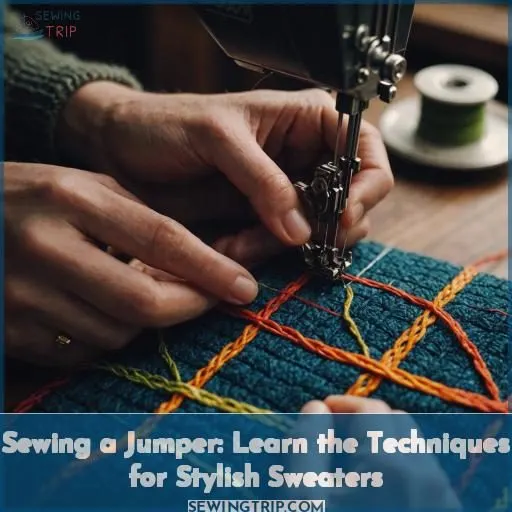
To use a jumper in sewing**, start by carefully selecting the right fabric – consider texture, light interaction, and color.
Design your jumper with details like sleeve style, neckband, and a customized fit.
Measure and cut your fabric precisely, folding it strategically and using a walking foot for smooth handling.
When sewing, master techniques like stretching the neckband, easing curves, and finishing edges to achieve professional results.
Don’t forget to stabilize high-stress areas and handle the delicate knit fabric with care.
By following these steps, you’ll create a stylish, well-fitted jumper that reflects your personal style.
Table Of Contents
Key Takeaways
- Choose the right fabric for your sweater, considering texture, light interaction, and color.
- Design your sweater with details like sleeve style, neckband, and a customized fit.
- Master techniques like stretching the neckband, easing curves, and finishing edges to achieve professional results.
- Handle the delicate knit fabric with care and stabilize high-stress areas.
How to Use a Jumper in Sewing?
In sewing, a jumper, such as a Bulky Seam Jumper or Hump Jumper, is used to help the sewing machine’s presser foot glide smoothly over thick seams or layers, ensuring even stitches. This tool levels the presser foot, preventing skipped stitches and needle breakage when sewing heavy materials like jeans or upholstery.
Choosing the Right Fabric
When choosing your sweater knit, contemplate the fabric texture and how it’ll interact with light—a plush thread size hints at extravagance.
Seam allowance is more than a mere measurement; it’s the room for your creation to expand. Your color choice establishes the tone, while an appropriate pattern selection ensures your sweater won’t merely hang—it’ll embrace you.
So, seize that pattern, wield your scissors confidently, and prepare to carve your path to a custom masterpiece. Remember, crafting your own sweater isn’t merely a hobby—it’s summoning comfort.
Designing Your Jumper
Designing your jumper involves choosing the right sleeve style, fabric, and pattern. For sleeve styles, consider dolman or raglan sleeves. Select a suitable fabric, such as Sincerely Rylee Fabric or Raspberry Creek Hacci Sweater knit.
Create your pattern by using a shirt that fits well, measuring from shoulder to underarm for loose underarm fit, and measuring around the low waist for desired width. Cut your fabric, folding it in half and laying the shirt half on and half off. Extend dolman sleeve ends a couple of inches past the end of the t-shirt sleeve.
For neckband design, cut sweater knit or knit fabric and stretch it slightly to fit the neckline. Sew the neckband with a stretch stitch.
For finishing options, use a coverstitch machine to hem sleeves and top-stitch the neck. Use pattern weights and a rotary cutter for cutting. Sew with a ballpoint needle and a long straight stitch or zig-zag stitch. Use a differential feed on your serger to finish edges.
Measuring and Cutting Your Fabric
Now that you’ve designed your jumper, it’s time to measure and cut your fabric. Start by choosing a fabric that suits your design and feels comfortable against your skin.
When cutting, be sure to fold the fabric in half and lay your shirt half on and half off to guarantee proper pattern placement. Don’t forget to measure from shoulder to underarm for a loose underarm fit and around your low waist for the desired width.
When cutting, handle the fabric with care and use a walking foot to prevent stretching. Remember to mark notches with pins and cut cleanly to avoid cutting errors.
Finally, pay attention to seam allowances and make sure they’re consistent throughout your project.
Sewing Your Jumper
Now you’ll sew one shoulder to the sleeve and then the other shoulder before adding the neckband. To create a smooth neckband, you’ll cut it from sweater knit or knit fabric, then stretch it slightly as you stitch it to the neckline.
Sewing One Shoulder to the Sleeve
Joining the shoulder and sleeve is a fundamental step in crafting your jumper. Begin by aligning the shoulder seam of the sleeve with the shoulder seam of the bodice. Utilize a walking foot on your sewing machine to facilitate seamless sewing and prevent deformation. Adjust the stitch length to a longer setting, such as 3.0 mm, and employ a wobble stitch for enhanced elasticity.
After sewing the shoulder seam, you have the option to insert the neckband or attach it with only one shoulder sewn. For the neckband, cut knit fabric or sweater knit to the preferred width and length. Gently stretch the neckband to conform to the neckline, then stitch all three layers of fabric together using a stretch stitch.
Lastly, attach the sleeves to the shirt and hem or cuff the sleeves, completing the hem before sewing the side seams. Smoothly transition the curve for a curved hemline, and utilize a coverstitch machine to hem sleeves and top-stitch the neck.
Cutting Sweater Knit or Knit Fabric for the Neckband
To cut sweater knit or knit fabric for the neckband, follow these steps:
- Determine the neckband material and width based on the neckline of the jumper.
- Measure the neckband placement and shape to guarantee a comfortable fit.
- Press the neckband fabric to remove wrinkles and creases.
- Stitch the neckband with a stretch stitch to accommodate the neckline’s curvature.
Stretching the Neckband Slightly to Fit the Neckline
Adjusting the neckband precisely ensures neckline stability. It’s akin to tuning a guitar; excessive tightness may cause a string to break. Strive for a balance between neckband tightness and elasticity.
| Neckband Tightness | Neckband Attachment | Neckline Measurement |
|---|---|---|
| Precisely adjusted | Secure | Exact |
| Too tight | Risky | Uncomfortable |
| Too loose | Floppy | Unstable |
Sewing Up the Hem Before Sewing Side Seams
Sewing up the hem before sewing side seams is crucial to guarantee a perfect fit and prevent any puckering. Here’s how:
- Measure your hem allowance, taking into account the elasticity of your fabric.
- Pin the hem in place, smoothing out any creases.
- Use a serger stitch or split hem bottom band for a curved hemline.
- Press the hem gently, avoiding any warping.
Easing the Curve for a Curved Hemline
To ease the curve for a curved hemline on your jumper, start by sewing up the hem before sewing side seams. This allows for better fabric stability and seam reinforcement.
When pressing, use only the tip of your iron and be careful not to distort the fabric. If your fabric has wool in it, handwash for best results.
For a curved hemline, use a walking foot and ease the curve.
For raglan sleeves and arm cuffs, consider using Sincerely Rylee Fabric or Raspberry Creek Hacci Sweater knit.
Finishing Touches
Now that you’ve sewn your jumper, it’s time to add those finishing touches.
Start with coverstitch hemming for your sleeves and top-stitching the neckline. If you’re using a serger, learn how to use it for finishing the edges.
Remember to handle your fabric with care during these processes, as you don’t want to distort its shape.
With these final steps, your stylish sweater will be ready to wear and impress.
Tips and Techniques
When sewing a jumper, be sure to overcast all edges after cutting to stabilize them. You’ll also want to use appropriate stabilization at the shoulders and other high-stress areas to guarantee your sweater holds its shape.
Overcasting All Edges After Cutting to Stabilize Them
Overcasting all edges after cutting stabilizes them and gives a neat appearance. To overcast edges, attach an overedge foot on your sewing machine and set it for overcasting with a 5 mm width and 1 – 2 mm length. Adjust the thread tension if necessary and stitch while guiding the fabric against the guide.
Overedge stitching prevents edges from fraying and imitates a serger.
Using Appropriate Stabilization at Shoulders and Other Necessary Areas
In the realm of jumper sewing, don’t let sagging shoulders dampen your spirits. Implementing stabilizing methods guarantees that your shoulder reinforcement will endure, preserving fabric integrity and averting tears. It’s akin to providing your seams with a spine, ensuring that each stitch supports the garment’s framework without hesitation.
| Technique | Purpose | Benefit |
|---|---|---|
| Clear Elastic | Shoulder Reinforcement | Maintains Shape |
| Twill Tape | Seam Support | Prevents Stretching |
| Interfacing | Fabric Integrity | Adds Structure |
| Bias Tape | Tear Prevention | Reinforces Edges |
| Serger Overlock | Overall Stability | Secures Edges |
Handling Fabric With Care During Cutting, Sewing, and Pressing
Handling fabric with care is essential when cutting, sewing, and pressing knit fabrics. Here are some tips to achieve optimal outcomes:
- Cutting: Employ a rotary cutter and pattern weights for precise and straight cuts. Mark notches with pins and treat the fabric delicately to avoid stretching or distortion.
- Sewing: Utilize a ballpoint needle designed for knits to prevent missed stitches and damage to the fabric. Sew at a consistent speed and reinforce seams under pressure to ensure durability.
- Pressing: Use only the tip of your iron when pressing a textured knit, and don’t iron the fabric itself, only the seams. Take care not to distort the fabric while pressing, as it can retain stretching if pressed while stretched out.
- Washing: Handwash your knit fabric in cold water with mild soap, and lay it flat to dry to prevent distortion.
- Stabilizing fabric: Finish all edges after cutting to stabilize them and prevent fraying. Use appropriate stabilization at shoulders and other necessary areas to maintain the shape of your sweater.
Frequently Asked Questions (FAQs)
What is the recommended needle size for sewing with sweater knits?
As a seamstress, you’ll want to hone in on that Goldilocks zone – not too big, not too small. For sweater knits, a ballpoint needle size 11 or 14 will be just right, allowing your stitches to glide through the fabric without a hitch.
Can I use a regular walking foot for sewing with sweater knits, or do I need a special one?
Yeah, a regular walking foot will do the trick with sweater knits. The key is to go slow and steady, letting the feed dogs guide the fabric through. Just take your time and you’ll nail those sweater seams.
How do I prevent the edges of my sweater knit fabric from fraying?
To prevent fraying, overlock the raw edges of your sweater knit using your sewing machine’s overedge stitch function. This nifty trick locks down the fibers and keeps your cozy creation looking sharp.
What is the best way to finish the raw edges of a sweater knit seam?
To keep your sweater knit edges in tip-top shape, stitch ’em up with an overcast or zigzag stitch. Tame those frayed edges and give your creation a professional look that’ll have folks green with envy.
How do I avoid skipped stitches when sewing with sweater knits?
To avoid skipped stitches with sweater knits, switch to a ballpoint needle and lengthen your stitch. Go slow and steady, using your walking foot to gently guide the fabric. Don’t overstretch or distort the knit as you sew.
Conclusion
Surely, crafting your very own jumper has never been simpler! By mastering the art of using a jumper in sewing, you’ll gain access to the ability to create stunning, one-of-a-kind sweaters that will have your friends and family green with envy.
With the techniques you’ve learned, you’re now equipped to design, construct, and perfect your dream jumper, reflecting your unique style and personal flair.
Get ready to elevate your sewing game and become the talk of the town with your handmade jumper prowess.

